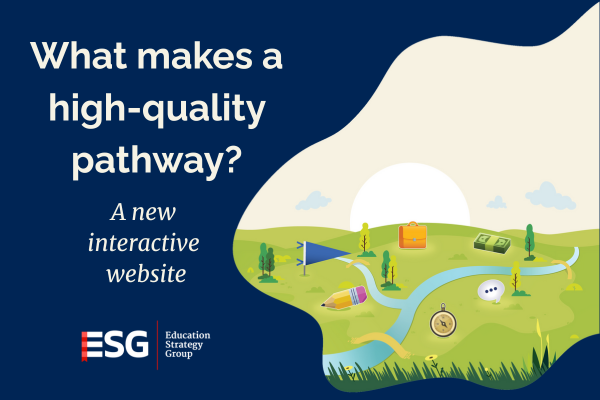Behind the Scenes: Building WhatIsaPathway.org

Co-author: Dany Rossman
There is a growing demand for career-connected learning in high school; students and their families want authentic experiences that will help them to determine which courses and offerings, when combined together, offer the best path to an in-demand career and fulfilling life.
More and more schools and districts are exploring various ways to deliver these “pathways” for their own students. And while the concept of a pathway is fairly straightforward—a roadmap of classes and experiences that begin in high school and lead to a college degree or credential and a good job—the ways in which those pathways are implemented exhibit significant variability.
WhatIsAPathway.org is an effort, alongside many of our peers, to establish a clear understanding of the ingredients that are necessary to ensure students are actually building toward their future meaningfully.
Engaging Stakeholders
To build the site, we convened an expert working group with representatives from several of the organizations who have been in the trenches with ESG over the past decade, supporting pathways missions and mandates. We quickly reached consensus on a mission for the website: defining for the field what is a “high-quality” pathway. But from these conversations emerged a list of beliefs and assumptions that we knew needed to be reconciled on this new site:
- How do we imply intentionality without implying a rigid sequence of experiences?
- How can we ensure the greatest number of students see themselves reflected within the experience?
- How do we shift away from “College OR Career,” toward a more inclusive perception of “College AND Career”?
- Can we help close the information gap between what parents/students want and the administrators who are making decisions about programming and offerings?
In addition to collecting feedback from the expert working group, we engaged a messaging research firm to conduct a series of parent and student qualitative interviews to help understand what language resonated, and what was just causing confusion. Here is what we heard:
- Many either have heard of or know the term “career pathways” or intuitively understand what it means. However, they don’t necessarily think of the high school to college/career journey as an intentional “sequence of events.”
- For some parents, adding the phrase “high-quality” before “pathway” indicated a high-paying career with a lot of education (i.e., lawyer, doctor), as opposed to describing the quality of the experience itself.
- “Postsecondary” is not a term parents use with any frequency.
- Parents believe that career exploration, network building, and work-based learning experiences are essential.
- Some respondents were unfamiliar with the terms “Dual enrollment” and “Credentials,”
- Most were confused by the phrases “Intentional labor market alignment” and “Robust advising”
Creating an Immersive Experience
Taking what we learned from our expert workgroup and messaging research and combining it with our own experience leading this work, we created an interactive world where users can select a student avatar, and navigate through a series of intentional “pathway” experiences together. The “journey” includes clear and concise descriptions and shows users how all of the pieces layer and click into one another. Sometimes “seeing” a pathway is much easier than imagining it, especially for those of us who experienced high school in a very different (and much less coherent) way.

Each “checkpoint” on the journey correlates to one of seven critical components of a high-quality pathway: Career awareness; advising support; connection to in-demand, well-paying jobs; an engaging series of courses; early college opportunities; work-based learning experiences; and networks and relationships. And nestled within each of these way stations is information for families, community members, and policymakers about why each particular component matters, examples of how real places are already implementing these ideas, and more information to better understand what comes next.

We hope everyone enjoys this unique and valuable interactive experience, and that it empowers more students and families to navigate a high-quality pathway to the career they are passionate about and the life they envision for themselves.



